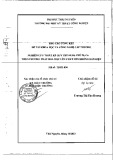
NANO EXPRESS
High-rate low-temperature dc pulsed magnetron sputtering
of photocatalytic TiO
2
films: the effect of repetition frequency
J. S
ˇı
´cha ÆD. Herˇman ÆJ. Musil ÆZ. Stry
´hal Æ
J. Pavlı
´k
Published online: 27 February 2007
To the authors 2007
Abstract The article reports on low-temperature
high-rate sputtering of hydrophilic transparent TiO
2
thin films using dc dual magnetron (DM) sputtering in
Ar + O
2
mixture on unheated glass substrates. The
DM was operated in a bipolar asymmetric mode and
was equipped with Ti(99.5) targets of 50 mm in diam-
eter. The substrate surface temperature T
surf
measured
by a thermostrip was less than 180 C for all experi-
ments. The effect of the repetition frequency f
r
was
investigated in detail. It was found that the increase of
f
r
from 100 to 350 kHz leads to (a) an improvement of
the efficiency of the deposition process that results in a
significant increase of the deposition rate a
D
of sput-
tered TiO
2
films and (b) a decrease of peak pulse
voltage and sustaining of the magnetron discharge at
higher target power densities. It was demonstrated that
several hundreds nm thick hydrophilic TiO
2
films can
be sputtered on unheated glass substrates at
a
D
= 80 nm/min, T
surf
< 180 C when high value of
f
r
= 350 kHz was used. Properties of a thin hydrophilic
TiO
2
film deposited on a polycarbonate substrate are
given.
Keywords TiO
2
film Hydrophilicity Deposition
rate Unheated substrate Dual magnetron sputtering
Polycarbonate
Introduction
Titanium dioxide (TiO
2
) is well known photocatalyst
with good chemical stability, high refractive index,
nontoxicity and good mechanical hardness. In recent
years, photoinduced hydrophilicity characterized by
the decrease of the water droplet contact angle
(WDCA) to almost 0on the TiO
2
films surface has
been also reported. For these unique properties, TiO
2
can be used for the preparation of self-cleaning, anti-
fogging and antibacterial self-sterilization coatings
[1–3]. However, there are several problems which
prevent a higher utilization of the TiO
2
photocalyst. A
photoexcitation of an electron-hole pair by photons
with wavelengths less than 385 nm (UV light region) is
required due to an optical bandgap energy E
g
= 3.2 eV
for the TiO
2
anatase phase [4]. The photoexcitated
electrons and holes play a crucial role in the photo-
catalytic and hydrophilic behaviour of the TiO
2
films.
Therefore, the first problem is connected with the
activation of the TiO
2
films because the UV light
covers only a small fraction of the total sun radiation.
This article is devoted to the low-temperature (low-
T) sputtering of the TiO
2
films with deposition rates
sufficient for industrial production. Such a process is
urgently needed for the preparation of films on heat
sensitive substrates, such as polymer foils, polycarbon-
ate (PC), etc., at low substrate surface temperatures
T
surf
, e.g. T
surf
< 130 C in the case of the polycarbon-
ate [5]. Recently, it has been shown that T
surf
can be
much higher than that measured by a thermocouple
incorporated in a substrate holder [6]. Among many
preparation methods [7–12], the magnetron sputtering
is a very promising technology for a low-temperature
deposition of the high-quality crystalline hydrophilic
J. S
ˇı
´cha D. Her
ˇman J. Musil (&)
Department of Physics, University of West Bohemia,
Univerzitnı
´22, Pilsen 306 14, Czech Republic
e-mail: musil@kfy.zcu.cz
Z. Stry
´hal J. Pavlı
´k
Department of Physics, J.E. Purkyne
ˇUniversity, C
ˇeske
´
mla
´dez
ˇe 8, Usti nad Labem 400 96, Czech Republic
123
Nanoscale Res Lett (2007) 2:123–129
DOI 10.1007/s11671-007-9042-z






























